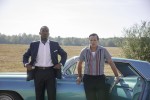“Blue Cadillac” would have been a more apt name for “Green Book” – the car is featured more prominently than the titular guide book, historically used to help black travelers find safe accommodations.
While “Green Book” certainly wasn’t terrible, the contentious best picture is a flawed pick for the Oscars’ top award, especially in a year filled with strong contenders. The film’s win indicates the Academy’s deep misunderstanding of the film’s questionable attempts to capture American racism at large.
“Green Book” tells the story of an unlikely friendship between Tony Vallelonga (Viggo Mortenson), a rough-around-the-edges New Yorker, and Dr. Don Shirley (Mahershala Ali), the African-American classical pianist. As Shirley tours the American south, he hires Vallelonga as his driver. Vallelonga is introduced as someone so racist that he is disgusted by the thought of drinking out of a glass previously used by a black man. Yet through the course of a three-month business engagement, he reaches a point where he both advocates for Shirley and invites him to his home.
Furthermore, the film is supposedly “inspired by a true friendship” and is based on Vallelonga’s life. While historical films often take some creative liberties, it seems the film did little to research or represent the characters and history accurately. The script was written by Nick Vallelonga, Tony’s son, without any consultation with the Shirley family. When the film premiered, various members of the family called it “full of lies,” saying that it misrepresented Shirley and the nature of his relationship with Vallelonga.
The family cited numerous discrepancies between the movie and reality – Shirley was not estranged from his family as the movie suggests, nor was he unaware of how to eat fried chicken, as a particularly tasteless scene in the film suggests. Family members also claimed that Nick Vallelonga misrepresented the relationship, transforming their strictly employer-employee relationship into a friendship. Shirley’s niece Carol Shirley Kimble put it best, saying that the filmmaker chose to depict a white man’s version of a black man’s life, undermining her uncle’s agency and presenting Vallelonga as the hero of the story for being less racist by the end of the story.
To make matters worse, after the Oscars, Nick Vallelonga fielded a question asking why he didn’t consult with the family. In response, he said he didn’t even know that the Shirley family really existed. In a similar vein of omission, when “Green Book” won best picture, the producers’ acceptance speech failed to mention Shirley or the guide book from which the film took its title.
This lack of research and perspective isn’t just a hiccup in the writing process – it permeates the perspective of the film. Shirley is a mere supporting character in his own story, and each scene in which Ali shines is a reminder of the more compelling movie that could have been created. Instead, the film presents Shirley as a victim of racism, constantly getting himself into predicaments from which he needs saving.
The audience is quickly introduced to Vallelonga’s racism when his wife offers two black construction workers a drink of water. When the workers set the glasses down, Vallelonga scoops the cups into the garbage can. The moment is treated as a piece of simple character establishment, but the film minimizes the implications of deep-seated prejudice that the scene incurs – it’s not just a discomfort with people of color, but an active view of their inferiority.
And yet Vallelonga is able to simply bounce back without any particularly challenging moments or deep thought. Simply being in Shirley’s presence somehow ‘fixes’ him, an arc that is both too neat and deeply unrealistic – Vallelonga’s redemption is never earned. Racism is messy and ugly, but “Green Book” wants audiences to believe that getting to know one black person will obliterate it.
The film’s failings reveal a desire to boil down America’s deep racial divides into a solvable problem by illustrating racism as an interpersonal issue, a framing that ignores the larger, structural issue of institutional racism. Racism cannot be solved merely through a single friendship because it permeates our culture and our society, structuring our world. That’s not a feel-good illustration, but it is the truth – one that “Green Book” tries to work around.
If the Academy truly wanted to reward a film that tackled race in a nuanced and interesting way, there were plenty of films that did so, from “The Hate U Give” to “BlacKkKlansman.” The latter in particular provides sharp contrast, particularly because of the film’s unapologetic portrayal of racism’s continuing legacy and violence.
Or perhaps next year, the Academy could honor the recent documentary “The Green Book: Guide to Freedom,” which actually looks at the historical legacy of the original “Negro Motorist Green Book.”
But “Green Book” did neither. Perhaps the film was made with “love,” “tenderness” and “respect” as producer Jim Burke stated in his acceptance speech, but the gap between intention and reality reveals a reductive ignorance not at all exemplary of modern cinematic achievement.
